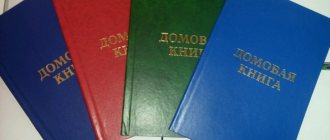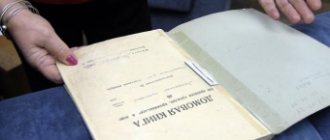What is a household ledger?
Household book in a rural settlement - what is it?
One of the forms of use of land plots by private individuals is the conduct of personal subsidiary agriculture (LPH).
The main purpose of carrying out this activity is to satisfy one’s own needs and wants. Making a profit is not the primary goal of the person who received land for private household plots.
According to the law of 07.07.2003 N 112-FZ of the same name, running such farms does not apply to commercial activities.
Therefore, it is not subject to registration in the appropriate manner. However, this does not mean that its implementation occurs uncontrollably.
Records of farms operating in a certain area are kept in special documents - household books. Their registration occurs in accordance with the established Order of the Ministry of Agriculture of the Russian Federation dated November 11. 2010 N 345 sample.
The compilation of these books is carried out by the authorities of the locality in which the farm is located. Currently, they are maintained not only in paper, but also electronically.
Certificates and protocols confirming the fact of work on the collective farm (experience for pension)
Since information about work on the collective farm was not always included in work books, for example, this was not an urgent need for a young man, upon retirement many people began to need to confirm the length of service worked on the collective farm.
A certificate was issued to Pavel Stepanovich Serikov stating that he has been a member of the Zarya collective farm in the Matveevo-Kurgan district of the Rostov region since 1943; according to available documentation, he worked on the collective farm from September 7, 1943 to September 1, 1944. The certificate was issued on the basis of a protocol for interviewing witnesses to establish work experience dated August 13, 1993.
To confirm this fact, a protocol was drawn up, which included the testimony of witnesses confirming the fact of work. A certificate was issued with which the person applied for a pension. The certificate indicated the name of the collective farm and the terms of work.
Protocol of the Zarya collective farm, Matveevo-Kurgan region, to Pavel Stepanovich Serikov on work on the collective farm
What information does it contain?
What can you learn from such a book?
Household books are not compiled for each household separately. They represent a single document about all farms in a certain village or other area.
When recording all private household plots located in a certain area, a separate record (personal account) is created for each of them.
They contain the following information:
- personal account number and farm address;
- information about all its members;
- area of land occupied by plantings and crops;
- its cadastral number;
- about the rights to the existing plot;
- on the number and composition of bred animals, birds, bees;
- about available agricultural equipment and machinery.
According to the established procedure, one of the members of the household is recorded in the book first. In fact, he is recognized as the head of the specified farm. For all other persons, not only personal data is indicated, but also the relationship to the person recorded first.
Detailed procedure, according to the Order
Order of the Ministry of Agriculture of the Russian Federation N 345 established a detailed procedure for maintaining household books in rural settlements:
- The book is maintained by local governments of the settlements on whose territory subsidiary farms are located.
- The head of this body ensures the organization of document maintenance and appoints responsible officials for the safety of the book and the confidentiality of information.
- Information is stored on paper or electronically, certified by electronic digital signatures of officials and members of farms. A backup copy must also be created on electronic media.
- In paper form, the book is kept on numbered and stitched A4 sheets. Numbering in order is carried out only on the front side. The number of sheets is indicated on the last page, the entry is certified by the signature and seal of the head of the local government. If the cover is not stitched, then it must be made of reliable material that guarantees the safety of the book.
- Based on a legal act, books are pledged for 5 years, indicating the number and number of pages. At the end of the period, an act on the new laying of documents for the same period is issued.
- Books are stored for 75 years before being transferred to municipal and state archives.
- Entries are made by officials from July 1 to July 15. Crossing out or correcting entries without notes is not permitted. Any amendments and corrections must be certified by the signature of an official.
- A personal account is opened when the book is bookmarked. The l/s number is the serial number of the farm record; it is indicated when drawing up notices, certificates and statements on the farm.
- The book includes all areas where farming is carried out, even if there are no residential buildings on them or they are collapsed, dilapidated, or burnt out. Individual residential buildings, such as farmsteads, sidings, railway stations, forest guardhouses or booths, are also subject to registration. To record new farms in the book, you must leave blank sheets.
Section I
The household ledger consists of several sections. In the first section you can enter the following information:
- In the “Farm Address” column, you must enter the street, house and apartment number. In this line you can also indicate the name of the locality.
- Members of private household plots write down the head of the household first, indicating his full name. and passport details. If the passport data is changed, the entry is crossed out and the new data is entered in a free line, indicating the date of the changes and the reasons, for example, “due to loss” or “upon reaching 45 years of age.”
- If the head of the household is replaced by another person, then the full name is entered at the top of the l/s. and passport data of the new head, and all data of the previous head are crossed out.
- Other members of the household are recorded according to the words of the head. A record is kept of present and temporarily absent members of the private household plot. Their full name written down in full and without abbreviations.
- In the line “other members of the household” the family relationship to the main member of the private household plot is indicated: “wife”, “husband”, “daughter”, “son”, “mother”, “father”, “brother”, “sister”, “mother-in-law” "son-in-law". Foster children are recorded as "foster care".
- The “Gender” line indicates “male” or “female.” Abbreviations “male” are allowed. or “feminine,” but one letter “m” or “f” is not allowed. The column is required to be filled out.
- In the line “Day, month, year of birth” the data of each family member is recorded based on the relevant documents. The date must be written in Arabic numerals; the month can be indicated in words. It is not allowed to write the year in the last two digits, only in 4 Arabic numerals.
- If the residence of family members on the farm is not permanent, but temporary during the summer season, then this information is reflected in the line “Note on residence and housekeeping.”
- The first section is designed for private household plots with up to 5 members. If there are more persons, then two or more sheets are allocated for recording with the note: “Continuation of personal account No. ___.”
- If after laying the book for 5 years the number of members has increased, then an insert with a serial number and the letters “a”, “b” is pasted in. On the last page there is a note about pasting in a sheet with a number.
- Departing members are deleted from the book, with information about the reasons for departure and the date of departure.
Section II
This section records the area of plots on the farm . The sown area and crops between the rows of the gardens are taken into account. Gardens, green lawns, flowers and paths are not taken into account.
If the documents for the land plot were registered not only in the name of the main member of the private household plot, then the book indicates which member the given territory was registered in the name of.
When filling out the column on land rights, you must indicate the number of the supporting document.
Section III
Section III indicates the number of livestock after their recalculation in the presence of the head of the farm, when farm animals are on the territory of the farm. The number of birds and bee colonies is recorded according to a survey of the head of the private household plot.
If the farm contains animals and birds that do not belong to members of the farm, then information about the animals is included in the additional information in this section.
If the farm contains non-farm birds or animals that are not listed in the section, for example, ostriches, pheasants, camels, moose, then they are recorded in the open lines “Other species”. Along with the name of the bird or animal, its age is indicated. If desired, you can list the breeds of animals.
All information is recorded as of July 1 of the current year. Information on changes in the number of animals and birds must be provided independently quarterly.
Section IV
This indicates the availability of vehicles, agricultural machinery and equipment on the farm as of July 1 of the current year, as well as the following information:
- If members of private household plots stop farming and move, then private households are closed with a note at the top of the sheet: “Personal account closed (date), due to (reason).” New owners open a new l/s in the same book. The numbers of closed l/s are not assigned to other farms.
- When merging plots, the l/s of one of the farms is preserved, and the l/s of the other farm is closed. Entries on the merger of farms are made at the top of the sheet.
- When dividing the farm, the retired persons are crossed out from the private plot, and the private household plot opens a new private plot in the book at the location of the plot.
- Any member of a private household plot has the right to familiarize himself with the records of private households, but only of his own household. Also, each member has the right to receive an extract from the household ledger for any purpose and for any list of information. The extract is drawn up in two copies, signed and certified by the seal of the manager or official.
Is it possible to challenge a record?
Sometimes, this question is quite relevant among rural residents, therefore, in this context it is impossible not to answer it.
Yes, you can challenge an entry previously made by the responsible person in this document, and for this you do not need to go to court and waste a lot of time and nerves.
So, to begin with, there are a number of reasons when you can challenge a record :
- For example, if there is information that you are the owner of 6 hectares of land, when in fact you only have 5.3 hectares. Having no desire to put up with the error, you can appeal the entry by contacting the head of the village council with a copy of the certificate of assignment of the land plot to you, where its actual area will be indicated;
- It may be that the record includes information about the presence of a large number of cattle. If the information is false or outdated, you need to contact the local administration with a request to change the entry due to the discrepancy with reality. If necessary, you can invite representatives of local authorities to personally verify the veracity of your words, that is, so that they visit your home and check everything.
For information on conducting household accounting in rural areas, see the following video:
and a ready-made form without registration
Since the provision of an extract from the household register is a municipal service, the application form for its receipt is also regulated by local regulations, which means that depending on the area, its type may be different.
You can download a sample form of such an application by following the link.
The form of the extract from the household register, on the contrary, was approved by order of the Federal Service for State Registration, Cadastre and Cartography dated 03/07/2012 No. P/103.
Extracts from the household ledger can be obtained by following the link.
Electronic version
An electronic household book is a modern solution to many issues, a unique way to save time and is easy to use.
Thus, the Ministry of Agriculture decided to create an electronic system (database) in which all information about each of the citizens of the Russian Federation who owns a subsidiary plot will be stored.
The rules for its maintenance are similar, the only thing is that its renewal period is slightly higher than that stated earlier. This is justified by the large amount of information that first needs to be processed, approved, and only then transferred to the electronic system.
It is also noted that now every person can notify the state about the purchase of housing, land or an animal. It's very easy to do this:
- Go to the official website of the Electronic Household Book;
- Log in to your personal account (before this you need to register and wait until the administration confirms your identity);
- Among the available functions, select “Make an entry” and proceed to filling out a special form in which you can indicate changes in your farm using the “tick” method;
- After that, you just need to “save the changes” and send them for processing.








